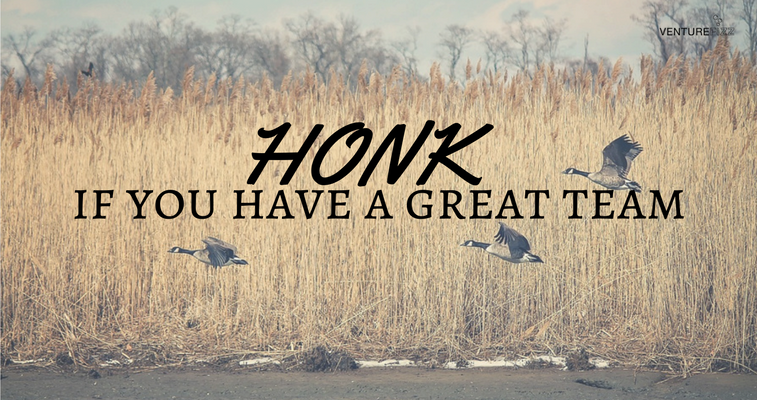With the cool air beginning to sweep through the east coast, the first signs of winter are upon us. As many of my parent’s generation start to pack up their belongings and head south for the winter, so do the thousands of geese flocking to retreat from the bitter Canadian air. Being ill at home today and watching the geese from my window, I reflected on how much those geese have in common with my work teams.
Comparing geese to teams isn’t a new concept. However, when considering them based on my own dealing with my teams during my absence, I was amazed to how much they truly do have in common.
When Canadian geese fly, they form a v shaped flying pattern. One goose takes center position, with the other geese flying close behind in two lines. And just why exactly do they do this? A few reasons. Take a read, and see if your team measures up to these brilliant creatures.
THEY PARTNER TOGETHER TO HELP THEIR BUDDIES
When geese fly together, each goose provides a bit of lift and reduces air resistance to the goose flying behind it. When they fly in a v formation, the whole flock can fly about 70% farther than if they flew solo. Greater distance, faster accomplishment, and less energy expended. Who doesn’t want that?
THEY REALIZE EVERYONE NEEDS A BREAK
When one goose drops from the formation, it realizes quickly it takes a lot more energy to play catch up. It moves quickly to play catch up, and receive that lifting power from others. Whether a team member is ill, goes on vacation, or is just has an off week, sometimes people need to rely on their teams to keep the pace for them. However, most quickly realize they benefit from the comradery and energy that comes from being part of cohesive team.
THEY TAKE TURNS
Taking the lead position can expend a lot of physical and mental energy. The goose at the center spends the most energy to provide that air lift for all the following geese. As is bound to happen, when the leader needs a break, it moves to the rear of the formation, where less energy is required. Another goose takes on that leadership position, and so follows the rotation of leadership. Much as with my own team this week, when I am down, someone else steps up. Perhaps the best leader for the time is determined by strengths, or other experiences. Perhaps they are just the best leader at the time. Regardless, it’s great when your team is strong enough that everyone has the opportunity – and competence – to play both the leader and follower roles.
THEY COMMUNICATE WELL
Geese make that rather annoying honking sound as they fly for a purpose; it’s how they communicate during their long journey. Obviously, this communication is just as vital to team members as they are working together to accomplish a goal. When strong communication fails to exist, the team often falls apart.
THEY HAVE EACH OTHER’S BACKS
I will never forget driving down the highway one morning, trying to determine what the traffic jam was. It was one goose who refused to leave the side of its partner, lying dead on the highway. Apparently when one goose is injured, two other will stay behind to help protect them from predators until it is able to fly again – or until it passes on. Similar to our own teams, we aid each other when one is not at our best.
I’ve got to admit, geese are not my favorite animal. However, there is much to learn from their brilliant approach to teaming and partnership. To my own team; thank you for picking up the slack when I was down. May we all learn from those around us – even animals – who seem to have it all figured out. Sometimes, even a little better than we humans do.
Christina Luconi is Chief People Officer for Rapid7. Follow her on Twitter: @peopleinnovator

